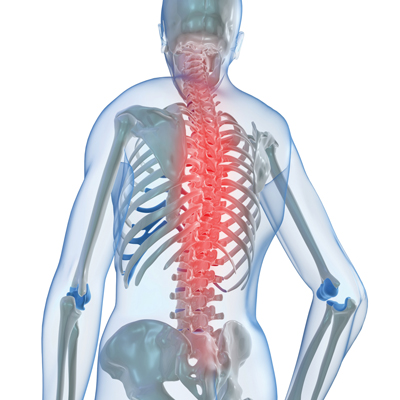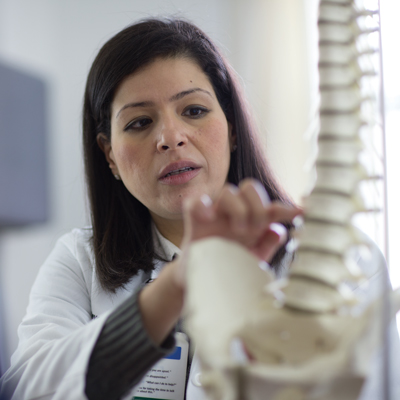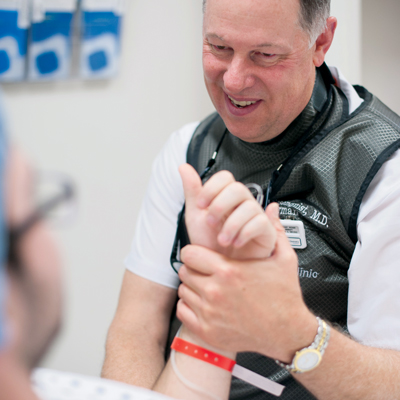Overview
Eighty to 90 percent of people in the United States will suffer from back pain at some time during their lives. Back pain is the second most common reason people visit their family doctors. On any given day, almost two percent of the entire United States workforce is disabled by back pain. It is the cause of enormous healthcare expenditures.
When to See a Back Pain Specialist
Many back disorders can be evaluated and treated successfully by a primary care doctor. However, for severe or persistent pain, evaluation by a medical spine or pain management specialist is recommended. Warning signs that should prompt urgent medical evaluation include the presence of fever, worsening pain, progressive movement of the pain from the back into the leg (radiating leg pain), numbness in the area of the injury or down the leg, presence of a lump or area with an unusual shape, and pain that is unrelieved at rest or disturbs sleep.
Types
The Most Common Types of Back Pain
Acute Back Pain
A brief episode of pain that comes on suddenly. Most acute back pain is due to mechanical causes, such as a strain or sprain, in which pain radiates from the spine and its supporting structures. The pain may spread to the buttocks, thighs or knees, and many sufferers also experience spasms. Mechanical back pain is generally more noticeable when flexing the back or lifting heavy objects.
Chronic, Persistent Back Pain
When back pain persists beyond four to six weeks, further medical evaluation is required. This pain is often related to the spinal joints, discs or supporting muscles of the back. In rare cases, cancer or an infection is found.
Causes

The back is a complex structure of bone and muscle, supported by cartilage, tendons and ligaments and fed by a network of blood vessels and nerves. The back – especially the lower back – bears much of the body’s weight during walking, running, lifting and other activities. It makes sense, then, that injuries to the lower back – such as strains and sprains – are common.
A common cause of low back pain is overstretched or injured muscles that support the lower back. Muscles and connective tissues can be injured from incorrectly lifting or carrying heavy objects. Muscles in the back or abdominal also can become weak from lack of exercise. Engaging in activity that involves pushing and pulling may increase the risk of a low-back injury. Other causes of low back pain include:
- Poor posture
- Standing or sitting in the same place for a long time
- Being significantly overweight
- Smoking
- “Slipped” disc, caused when a disc between vertebrae bulges past the bones and presses against a nerve
- Osteoporosis (thinning of bone)
- Osteoarthritis, a breakdown of the tissues or bones of the joint
- Fibromyalgia, an illness that causes achy, tender muscles
- Trauma from injury due to an accident or fall that causes a fracture or muscle strain
- Serious illnesses such as cancer or infection (this is rare)
Prevention is the most important management technique. Controlling the factors you can control may help you avoid or recover quickly from back problems.
Diagnosis

A careful evaluation of your medical history and a physical examination will help your healthcare provider determine the cause of your back pain. He or she will then work with you to create an appropriate treatment plan.
Your doctor may ask a series of questions to help identify possible causes of the pain. These questions may focus on lifestyle factors, when your pain began, where your pain is located, what effect it has had on your daily activities, and whether your pain has responded to any treatment. The doctor also will ask about your medical, surgical, family and social history.
Mild strains and sprains can usually be diagnosed based on a medical history — including a review of the method of injury and the symptoms — and a physical exam. In cases of more severe back pain, an imaging study may be ordered. If your symptoms or the examination suggest the possibility of infection, malignancy or a pinched nerve, additional tests may be needed. However, X-rays, MRI/CT scans, EMGs and lab tests are necessary in only a small number of cases.
The Mind-Body Issue
The mind and body often work together in shaping our experiences. Spine pain can carry a heavy psychological burden when patients are unable to participate in their daily activities. Depression or frustration may make the pain worse; on the other hand, a positive attitude and a sense of independence may lessen the pain.
Treatments

Conservative Care
Many people diagnose their own back pain based on experience, and treat the pain with over-the-counter medications and rest. Fortunately, most back injuries will heal with this conservative approach.
For patients who do not improve quickly, Cleveland Clinic providers will first explore nonsurgical treatment options for back pain. For moderate-to-severe strains and sprains, the treatment often occurs in two phases. The first phase, to reduce pain and spasm, may involve rest and the use of ice packs and compression (pressure), especially for the first 24 to 48 hours following an injury. An over-the-counter nonsteroidal anti-inflammatory drug such as ibuprofen (Motrin®) may be recommended to help reduce pain and swelling.
For the second phase, patients are encouraged to return to a near-normal schedule to promote rapid recovery from back pain. Bed rest is rarely recommended for the majority of spine pain conditions. Most people experience a full recovery within two weeks. If symptoms continue for more than two weeks, additional treatments may be required.
Families, friends and neighbors are often a source of advice on treating back pain. However, it is important to realize that everyone is different and it is never safe to take someone else’s medication. Always contact your healthcare provider before taking any medication that is not prescribed specifically for you.
Back and Neck Pain Care Continuum
Physical Therapy Treatment
For some patients, prescription pain medication and physical therapy are enough to control the pain. Rapid healing can be significantly enhanced through physical therapy, which focuses on the structures that support the spine. It is important to work with a spine-oriented physical therapist trained in an exercise approach. Most exercise programs can be performed at home without special equipment. The therapy will shorten recovery time and return you to work and leisure activities as quickly as possible.
Interventional Treatments
For a small percentage of patients, back pain remains chronic, persistent and disabling. For these people, more intensive treatment may be needed. Cleveland Clinic specialists offer the latest interventional treatments and technologies for back pain, including:
- Nerve blocks and injections
- Radiofrequency ablation
- Intradiscal ablation
- Continuous infusions of pain medications
- Spinal cord stimulators
- Intraspinal drug pumps
- Osteopathic manipulation
- Acupuncture
- Kyphoplasty
- SOUND Prescription Advice
Surgical Treatment
For some patients, surgery may be the only possible solution to alleviate back pain. Although spinal surgery is often delicate and complex, our surgeons have some of the highest success rates in the country for even the most complicated procedures. They also can offer the latest techniques, including minimally invasive and robotic surgery, which result in less postoperative pain and faster recovery.
In the hands of a skilled, experienced surgeon, the benefits of surgical treatment usually far outweigh the risks. The most common surgical procedures are for degenerative spine conditions such as disc herniation and spinal stenosis, followed by spinal deformity such as scoliosis and kyphosis, fracture/trauma and spine tumor.
Cleveland Clinic experts employ these treatment options to manage care of the following back and neck conditions, among others:
- Chiari malformation
- Degenerative back and neck disorders
- Disc herniation
- Revision surgery
- Spinal deformities, including scoliosis and kyphosis
- Spinal fracture
- Spinal stenosis
- Spinal tumor
- Spondylosis/spondylolisthesis
Whatever your diagnosis, our specialists apply their knowledge and skill, combined with the latest techniques and advanced technologies, to relieve your pain and restore your function to the highest degree possible.
Our Team
Therapy Services
For individuals with back pain present for less than three months, Cleveland Clinic spine physical therapists offer a comprehensive evaluation, assessment of functional ability and individual treatment sessions designed to offer multiple therapeutic options. Our staff is trained in a diverse number of treatment approaches. Each rehabilitation plan is tailored to the patient’s specific diagnosis, needs and goals. All treatment sessions are provided in a one-on-one setting and may include:
- Aquatic physical therapy.
- Core stabilization exercises.
- Correction of body mechanics.
- Development of a home exercise program.
- Joint manipulation/mobilization.
- Postural correction.
- Soft tissue mobilization.
- Stretching/flexibility exercises.
- Traction.
Medical Spine & Pain Management
For individuals with chronic pain, which rehabilitation has not improved, a consult with a medical spine or pain management specialist may be needed. Cleveland Clinic medical spine and pain management providers offer evaluation, on-going management and medical and interventional therapies for the treatment of chronic back and neck pain, including:
- Epidural steroid injections.
- Joint Injections.
- Nerve blocks.
- Pain pumps.
- Radiofrequency ablation.
- Spinal cord and peripheral nerve stimulators.
- Vertebroplasty and kyphoplasty.
Our team in the Center for Comprehensive Pain Recovery (CCPR), offers behavioral management strategies coupled with medication to help you to learn more about your pain and how to manage it. Programs for patients with chronic pain include:
- TREK for Success: This one-time class teaches you about pain and how to cope with and manage it, using foundations from Stanford University’s Empowered Relief™ program. It will help you learn about other CCPR programs.
- TREK for Surgical Success: If you’re considering spine surgery, this one-time class will help you learn how it can help pain management and surgical outcomes.
- Back on TREK: Learn how to manage chronic back pain. This program is designed for people who are still working and functioning, but who have spine pain that gets in the way of their everyday life.
- Ketamine Infusions: Low-dose ketamine infusions are offered by our center as part of a larger, comprehensive plan for patients.
- Chronic Pain NeuroRehabilitation Program: If you have complex pain that doesn’t respond to initial treatment, you might benefit from this intensive outpatient treatment program.
Spine Surgery
For individuals requiring surgical repair of their back or neck condition, Cleveland Clinic offers surgical expertise in treating the simplest to the most complex conditions. We use the latest approaches and technology to help give patients relief, including minimally invasive and robotic spine surgery. We utilize a team approach to ensure that every patient undergoing surgery has an individualized surgical plan including preoperative evaluation to optimize their care prior to surgical intervention. The goal is to minimize the risks and enhance the outcomes of surgery. Our surgeons offer expertise in treating the following conditions, among others:
- Cervical radiculopathy.
- Cervical myelopathy.
- Cervical spine deformity.
- Complex spinal revision surgery.
- Degenerative scoliosis.
- Iatrogenic spinal deformity.
- Adult idiopathic scoliosis.
- Adult kyphosis.
- Post-traumatic spinal deformity.
- Spine tumors (including all forms of primary and metastatic spine tumors).
- Spondylolisthesis.
Why Choose Us?
Each year, patients from around the world turn to Cleveland Clinic for specialized treatment of spinal disorders. Together, our teams provide relief to more than 30,000 adults annually — for conditions ranging from common complaints such as low back pain, to complex conditions like spinal deformities.
Specialists are dedicated to restoring function and relieving your pain to the maximum extent possible. Whether your goal is getting back to sports, work or hobbies, or just enjoying life, Cleveland Clinic rehab, spine and pain management specialists can help.
Cleveland Clinic back and neck pain specialists are part of Cleveland Clinic’s Neurological Institute and Anesthesiology & Pain Management Institute.
Appointments
Make an Appointment
To schedule an appointment with a back and neck pain specialist in:
- Cleveland, Ohio - call 216.636.5860 or 866.588.2264.
- Akron, Ohio - call 330.665.4100.
- Weston, Florida - call 877.463.2010.
Virtual Visits
Whether you're a new or existing patient, you can get an initial evaluation or follow-up care from a back pain specialist using your phone, tablet or computer. This means there's no travel or parking, less waiting and significant time savings. Call 216.636.5860 to schedule a virtual visit for you or a loved one and get details on cost and set-up instructions.
Virtual Second Opinion
If you cannot travel to Cleveland Clinic, help is available. You can connect with Cleveland Clinic specialists from any location in the world via a phone, tablet, or computer, eliminating the burden of travel time and other obstacles. If you’re facing a significant medical condition or treatment such as surgery, this program provides virtual access to a Cleveland Clinic physician who will review the diagnosis and treatment plan. Following a comprehensive evaluation of medical records and labs, you’ll receive an educational second opinion from an expert in their medical condition covering diagnosis, treatment options or alternatives as well as recommendations regarding future therapeutic considerations. You’ll also have the unique opportunity to speak with the physician expert directly to address questions or concerns.
Resources
Living with Back & Neck Pain
Here are some tips for living with persistent, chronic back and/or pain that you can start today:
- Medical compliance – It is important to take your medication as prescribed. By relieving pain symptoms, medications can facilitate an active, exercise-oriented rehabilitation program.
- Physical conditioning – This is particularly important for chronic pain patients. Carrying excess weight, smoking tobacco and drinking alcohol will exacerbate chronic pain. Active, exercise-oriented physical therapy is the cornerstone of treatment.
- Stress reduction – Stress makes pain worse. Not all stress is avoidable, but reducing or eliminating sources of persistent stress, where possible, will help in reducing your overall experience of pain.
- Interpersonal support – It is natural for others to become frustrated with a person’s chronic pain and complaints. You need to make a special effort to foster and maintain social support.
- Activities – One of the best strategies for living with chronic pain is distraction. It is important for self-esteem to maintain some work role if possible, establish a clear role in the family, take on regular interpersonal duties, and maintain hobbies or personal interests.
- Pain reduction techniques – Psychological approaches such as yoga, biofeedback and self-hypnosis are helpful in reducing chronic pain.
Keeping Your Back Healthy
It is not possible to prevent all back injuries, but you can take some simple steps to help lower the risk of a sprain or strain. Here are some “back-saving” tips:
- Eat a healthy, well-balanced diet to keep your bones and muscles strong.
- Maintain a healthy weight. Excess weight puts added stress on the structures of the lower back.
- Exercise regularly, including stretching, to keep your joints flexible and your back and abdominal muscles strong.
- Choose activities and sports, such as swimming and biking that do not place your lower back at risk of injury.
- Use good body mechanics when sitting, standing and lifting. Try to keep your back straight and your shoulders back. When sitting, keep your knees bent and your feet flat on the floor. Don’t over-reach, and avoid twisting movements. When lifting, bend your knees and use your strong leg muscles to help balance the load.
- Maintain good posture. If you start to feel sore or stiff, change your posture and modify your body mechanics. Your body will warn you, using pain as a signal, when your mechanics are improperly aligned.
- Practice safety measures to help prevent falls, such as wearing shoes that fit properly and keeping stairs and walkways free of clutter.
- Don’t smoke. Nicotine interferes with blood flow to the muscles.